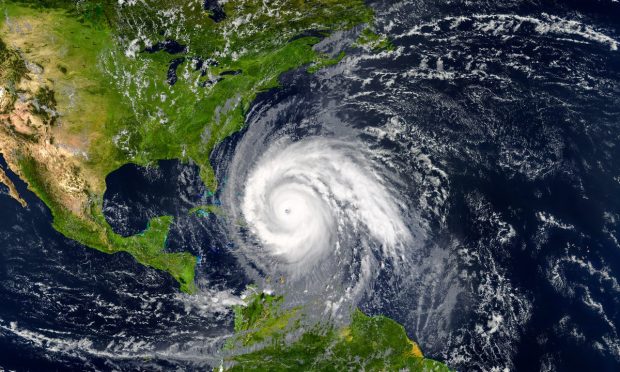Hurricane Season Puts Focus on Mitigating Financial Disruption of Natural Disasters

Greek philosopher Epicurus gets the nod for writing, “Skillful pilots gain their reputation from storms and tempest.” As wildfires, tropical storms, floods and hurricanes compound the COVID-crisis, there’s no shortage of tempests disrupting finances and financial markets in recent times.
The trick is to be that “skillful pilot” with business, specifically payments and the flow of funds.
It’s a point being underscored by nature itself — a lot — in just the past 18 months or so.
In late July a Reuters headlined blared, “Global supply chains buckle as virus variant and disasters strike” on a story noting that “deadly floods in economic giants China and Germany have further ruptured global supply lines that had yet to recover from the first wave of the pandemic, compromising trillions of dollars of economic activity that rely on them.”
According to analysis by the National Oceanic and Atmospheric Administration (NOAA), 2020 was the fourth-costliest year on record for natural disasters (not counting COVID). “In 2021 (as of July 9), there have been eight weather/climate disaster events with losses exceeding $1 billion each to affect the United States,” NOAA said, and “these events resulted in the deaths of 331 people and had significant economic effects on the areas impacted.”
To help banks and financial services firms harden defenses against severe weather disruptions, the Federal Deposit Insurance Corporation’s FDITECH unit opened registration on Aug. 30 for FDITECH’s Measuring Resilience tech sprint, inviting “experts in operational resilience, financial institutions, non-profit organizations, consumer advocates, academic institutions, private sector companies, and others” to submit disaster solutions. Winners will be named on Oct. 15.
It’s a clear acknowledgment that banks, financial institutions, payment service providers, FinTechs — the entire financial industry — needs better plans for storm-related disruptions.
September is National Preparedness Month
The FDIC keeps extensive records on the economic damage left in the wake of hurricanes of recent years and offers banks in affected areas ongoing guidance about disaster response.
In 2003 an alliance of U.S. government entities and agencies from the White House to FEMA and DHS created the Ready campaign, with planning and response information for consumers and businesses.
September has been designated National Preparedness Month, which the Consumer Financial Protection Board (CFPB) said “is aimed at promoting family and community disaster planning, including financial preparedness. This year, for many Americans who experienced financial challenges as a result of the coronavirus pandemic, preparedness means taking small steps toward rebuilding and resilience.”
Businesses have bigger steps to take, and the U.S. Small Business Administration (SBA) offers resources to help commercial interests in recovery efforts.
In its most recent Disaster Preparedness and Recovery Plan, the SBA said, “Through counseling and technical assistance, small businesses are able to adjust their plans to account for the ‘new normal’ after a disaster. The recovery process can be said to have resolved into the business cycle when the final steps in small business recovery are financed with SBA Offices of Capital Access (OCA) and Investment and Innovation (OII) programs investing in that same ‘new normal.’”
Showing how widely used these programs are, the SBA’s Economic Injury Disaster Loan (EIDL) program, on which recovering small businesses have relied for years, was tightly limited in 2020 as requests for emergency aid caused EIDL to run out of money.
Read more: SBA Shuts Door On SMB Disaster Loans
Helping FIs and Communities Weather Future Storms
Illustrating other aspects of government response to ongoing storms and natural disaster, on Aug. 27, 2021 the Office of the Comptroller of the Currency (OCC) issued a proclamation “allowing national banks, federal savings associations, and federal branches and agencies of foreign banks to close offices along the Gulf Coast of the United States and in other areas impacted by Hurricane Ida at their discretion.”
That type of action isn’t unusual after disasters. To get banks and financial institutions (FIs) reopened and serving customers after major weather-related disruptions, the OCC previously issued guidance to banks including things like “waiving or reducing ATM fees … temporarily waiving late payment fees or penalties for early withdrawal of savings for affected customers … working with borrowers who have been affected by the event by restructuring borrowers’ debt obligations, when appropriate, by altering or adjusting payment terms,” and “reassessing the current credit needs of the community and helping meet those needs by originating or participating in sound loans to rebuild damaged property.”
About Two Disasters Per Month
At a time of unprecedented cross-border trade, efforts like the World Bank’s longstanding Global Facility for Disaster Reduction and Recovery (GFDRR) in July said it’s providing the Caribbean nation of Jamaica with “financial protection of up to US $185 million against losses from named storms for three Atlantic tropical cyclone seasons ending in December 2023.”
With hurricane season running May to November this year, NOAA is predicting “another above-normal Atlantic hurricane season” in 2021, and the NOAA’s National Centers for Environmental Information (NCEI) has concluded that — COVID aside — that in 2020 “there were 22 separate billion-dollar weather and climate disasters across the United States, shattering the previous annual record of 16 events, which occurred in 2017 and 2011.”
NCEI said earlier this year that “billion-dollar events of 2020 included a record 7 disasters linked to tropical cyclones, 13 to severe storms, 1 to drought, and 1 to wildfires. The 22 events cost the nation a combined $95 billion in damages.”
In May 2021, the Biden administration announced it was huddling with FEMA after the disastrous 2020 season (pun not intended), saying in a statement that “it will direct $1 billion for communities, states, and Tribal governments into pre-disaster mitigation resources to prepare for extreme weather events and other disasters, and the Administration is announcing the development of next generation climate data systems at NASA to help understand and track how climate change is impacting communities.”
Also in May, the White House issued its Executive Order on Climate-Related Financial Risk, which states that “The Assistant to the President for Economic Policy and Director of the National Economic Council (Director of the National Economic Council) and the Assistant to the President and National Climate Advisor (National Climate Advisor), in coordination with the Secretary of the Treasury and the Director of the Office of Management and Budget (OMB), shall develop, within 120 days of the date of this order, a comprehensive, Government-wide strategy” regarding “measurement, assessment, mitigation, and disclosure of climate-related financial risk to Federal Government programs,” “financing needs associated with achieving net-zero greenhouse gas emissions for the U.S. economy by no later than 2050,” and “areas in which private and public investments can play complementary roles in meeting these financing needs.”
